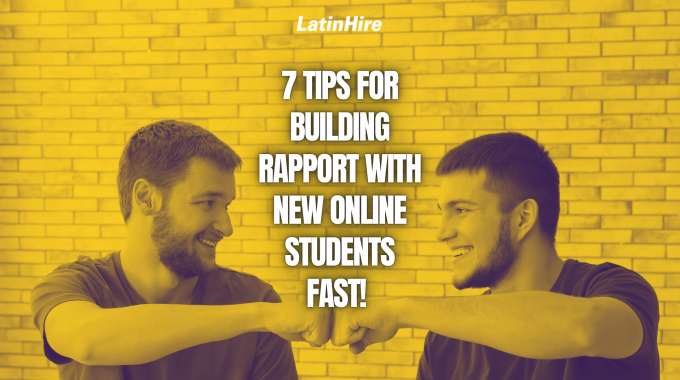December is a wonderful month filled with celebrations, end-of-year reflections, and excitement for the new…

7 Tips for Building Rapport with New Online Students Fast!
First impressions matter a lot, especially in a virtual classroom. As online teachers, we don’t have the luxury of getting to know our students face-to-face, so we depend on our screens and audio equipment to build a connection with them.
Just because you don’t have your students sitting right in front of you doesn’t mean you can’t create a genuine, lasting connection. In fact, building rapport quickly can set the tone for a productive and engaging learning experience throughout the rest of your classes.
No matter what subject you’re teaching online, here are some practical tips to help you connect with new students online fast!
1) Start with a Warm Welcome

A warm, enthusiastic greeting goes a long way. Use your student’s name right away and smile to create a positive mood. You might even share something simple about yourself, such as your city, favorite food, or what you did over the weekend. This humanizes you and invites your students to open up.
For example, you can say, “Hi [student]! I’m so happy to meet you. I’m teaching from Toronto today and it’s been snowing these past couple of days. Do you have snow where you live?”
2) Set a Friendly Tone with Icebreakers
Icebreakers are a fun and engaging way to get students talking from the get go. Keep it short and light. Ask your students about their hobbies, pets, or weekend plans. You can use fun games like “Two Truths and a Lie” or “Would You Rather” as icebreaker activities. Have a repertoire of online icebreakers ready so you can implement different ones in your various classes.
For younger students or shy learners, try using visuals or quick polls to get them to participate if they don’t feel comfortable answering open-ended questions at the start.
3) Be Present and Engaged

Show students that you’re truly listening. Nod, maintain eye contact through the camera, and respond to what they say. Refer back to things they’ve mentioned in later classes to show you remember and care. It may be a good idea to have a notebook by your side so you can jot down new information about different students as they present them. They will feel appreciated that you remember the little details!
For example, “Hi [student]! You mentioned last week you love drawing. Did you get to sketch anything new this past weekend? Do you have any upcoming art projects you’d like to complete?” These small callbacks can go a long way in building trust.
4) Personalize the Learning Experience
Try to adapt your lessons to match your students’ interests. If a student likes soccer, use it in your examples or writing prompts. If they love anime or video games, try to integrate those topics into your reading or math exercises. This not only makes the lessons more engaging, it also shows students you value their interests beyond the subject you’re teaching.
You can even get students to fill in a “Get to Know Me” questionnaire at the start of your classes so you have a collection of topics you can pull from in future classes.
5) Create a Safe and Positive Learning Space
Make it clear from the beginning that your classroom is a place where students can be themselves, make mistakes, and grow. Praise effort, not just correct answers. Be patient with language errors, tech issues, and general nervousness. Remind your students that everyone is there to learn and not to judge one another’s opinions.
Even a simple line like, “It’s totally okay if you’re feeling nervous. Just try your best in this class and let’s have some fun and learn something together!” can ease any tension right away.
6) Use Visuals and Body Language

In the absence of in-person cues, your facial expressions and tones become even more important. Use gestures with your hands, expressive language on your face, and visual aids like props or digital whiteboards to make yourself and the lesson come alive. This helps students feel more connected to you and more willing to participate.
Encourage your students to turn on their webcams during class, but don’t force it. Explain that they will have a more positive learning experience if their cameras are turned on, but if some are not comfortable, tell them that it’s okay.
7) Follow Up After Class
If you can, send a short message or email after your first lesson thanking the student for their time and their participation. Share at least one positive observation you made about this student during your class and possibly offer a suggestion for an area of improvement to give them something to work towards for the next class. This follow up message shows professionalism and reinforces a personal connection.
How do you build rapport with your new online students? Share your ideas in the comments below!



